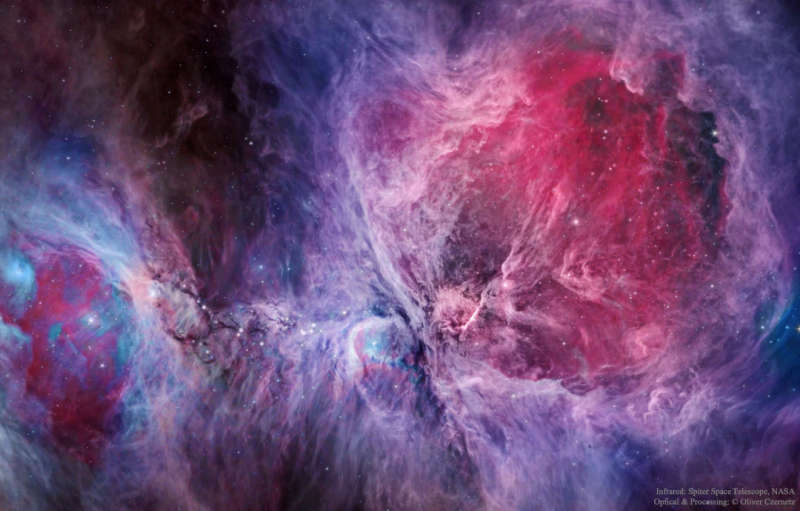
|
Credit & Copyright: Infrared: NASA,
Spitzer Space Telescope;
Visible:
Oliver Czernetz,
Siding Spring Obs.
Explanation:
The Great Nebula in Orion is a colorful place.
Visible to the unaided eye, it appears as a small
fuzzy patch in the constellation of Orion.
Long exposure,
multi-wavelength images like this, however, show the
Orion Nebula to be a busy neighborhood of young stars, hot gas, and dark
dust.
This digital composite
features not only three colors of
visible light but four colors of
infrared light taken by
NASA's orbiting
Spitzer Space Telescope as well.
The power behind much of the
Orion Nebula
(M42) is the
Trapezium -
four of the brightest stars in the nebula.
Many of the
filamentary structures visible are actually
shock waves - fronts
where fast moving material encounters slow moving gas.
The Orion Nebula spans about 40 light years and is
located about 1500
light years away in the same
spiral arm of
our Galaxy as the
Sun.
Follow APOD on:
Facebook,
Google Plus,
Instagram, or
Twitter
|
January February March April May June July August September October November December |
| |||||||||||||||||||||||||||||||||||||||||||||||||||||||
NASA Web Site Statements, Warnings, and Disclaimers
NASA Official: Jay Norris. Specific rights apply.
A service of: LHEA at NASA / GSFC
& Michigan Tech. U.
Based on Astronomy Picture
Of the Day
Publications with keywords: M 42 - Orion Nebula
Publications with words: M 42 - Orion Nebula
See also:
- Orion and the Running Man
- APOD: 2025 August 13 Á Trapezium: In the Heart of Orion
- APOD: 2025 April 20 Á The Orion Nebula in Visible and Infrared
- APOD: 2024 November 4 Á M42: The Great Nebula in Orion
- APOD: 2024 September 10 Á Horsehead and Orion Nebulas
- Trapezium: At the Heart of Orion
- APOD: 2023 October 10 Á Hidden Orion from Webb
